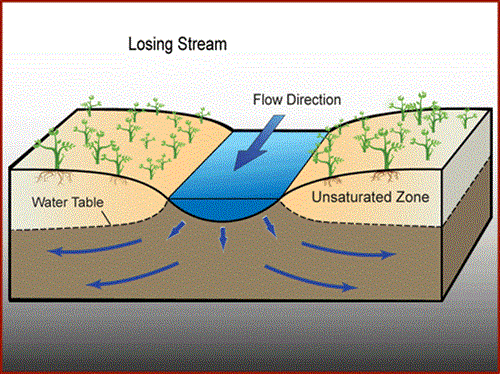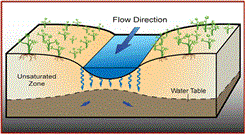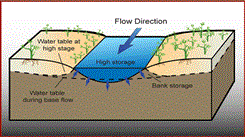Groundwater and surface water can be closely linked even when separated spatially. Each contributes to the other, with these interactions playing an important role in the hydrology of a region (USGS 2009).
Vegter and Pitman (1996) subdivided these interactions into three main streams:
-
Influent or losing streams: where the water table is below the stream bed, and the water flows from the stream bed through a porous material to recharge the groundwater (below);
-
Effluent or gaining streams: where the water table is above the stream and groundwater feeds into the stream (lower left);
-
A fluctuating water table: where the water table shifts up and down, determining periodic influent or effluent flow (lower right).

Influent or losing stream.
Source:Commonwealth of Australia 2006
( click to enlarge )
 Effluent or gaining stream. Source:Commonwealth of Australia 2006 ( click to enlarge ) |
 A fluctuating water table. Source:Commonwealth of Australia 2006 ( click to enlarge ) |
Groundwater contributes to the baseflow of a stream or river. It is also a significant contributor to surface water recharge, especially in higher rainfall regions. The interaction between surface and groundwater often depends on the elevation of the groundwater level. If the groundwater level is low, then aquifers may be recharged by the surface water body; if the groundwater level is high, it may be contribute to the surface water body. In shallow alluvial aquifers or riverbed sand aquifers, this normally depends on the seasonal cycle of rainfall and corresponding water level in the river banks (Pretorius and Dennis 2003).
In drier, western parts of South Africa, studies have shown that under natural conditions, groundwater contributes very little to base flow in rivers (ORASECOM 2007g). Hughes et al. (2007) also confirm that very few or no rivers in this region receive a baseflow contribution. However, it has been commonly observed that surface water recharge occurs in normally dry riverbeds.
Water quality problems are currently experienced in the Vaal, and the middle and lower Orange River (ORASECOM 2007g), where water-logging has resulted from irrigation activity along riverbanks. This indicates increased interactions between groundwater and surface water, with the saturated zone reaching right to the surface. However, this interaction has not been sufficiently studied in the Orange-Senqu River basin, and further research is required.
